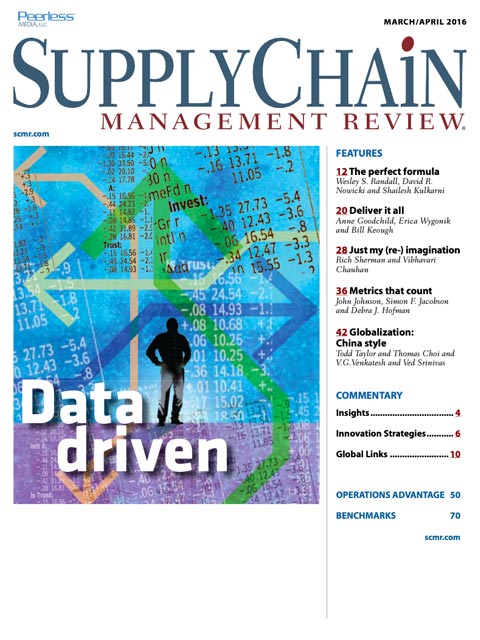Sorry, but your login has failed. Please recheck your login information and resubmit. If your subscription has expired, renew here.
March-April 2016
When I visit my millennial-aged daughter in Chicago, I’m amazed at the number of packages dropped off by UPS, FedEx and the USPS at her three-unit building on a daily basis. It’s as if she and her neighbors are single-handedly keeping Amazon in business. All those drop-offs got me to wondering: Does any of this make sense if you think about a carbon footprint? Rather than deliver millions of packages to one address at a time every day, wouldn’t it be more sustainable if we all just drove to the mall to do our shopping? After all, doesn’t research indicate that a signi cant percentage of consumers, especially millennial consumers like my… Browse this issue archive.Need Help? Contact customer service 847-559-7581 More options
“First do no harm” is an important tenet of medical doctors. While supply chain management is perhaps not as noble a profession as medicine, we do have a noble goal. Our goal (and real purpose in life) is to optimally match supply and demand over time. This is what I’ve termed optimized demand management. Paraphrasing the medical tenet, we should “first do no harm to true customer demand.”
Demand forecasts that support sales and operations planning (S&OP) processes need to represent estimates of future unconstrained demand—which reflects undistorted demand in terms of what, how much, and when customers really want their orders filled. In essence it reflects the fulfilled demand that would result if a company (unrealistically) had immediate and infinite supply available at all times. Based on unconstrained demand forecasts, the S&OP team plans supply; and once done “constrained” demand forecasts are one of the key outputs of the S&OP process.
I recall a comment made by the late Dick Clark during a discussion about the difference between constrained and unconstrained forecasts. A consummate industrial forecaster, Dick was P&G’s forecasting guru for several decades before he passed away some years ago. He doubted that “true” unconstrained demand existed. Until recently, I never understood what he meant by that because I viewed unconstrained demand as demand devoid of impacts due to supply shortages (e.g., that cause stock-outs and backorders).
 |
This complete article is available to subscribers
only. Click on Log In Now at the top of this article for full access. Or, Start your PLUS+ subscription for instant access. |
SC
MR
Sorry, but your login has failed. Please recheck your login information and resubmit. If your subscription has expired, renew here.
March-April 2016
When I visit my millennial-aged daughter in Chicago, I’m amazed at the number of packages dropped off by UPS, FedEx and the USPS at her three-unit building on a daily basis. It’s as if she and her neighbors are… Browse this issue archive. Access your online digital edition. Download a PDF file of the March-April 2016 issue. |
Download Article PDF |
“First do no harm” is an important tenet of medical doctors. While supply chain management is perhaps not as noble a profession as medicine, we do have a noble goal. Our goal (and real purpose in life) is to optimally match supply and demand over time. This is what I've termed optimized demand management. Paraphrasing the medical tenet, we should “first do no harm to true customer demand.”
Demand forecasts that support sales and operations planning (S&OP) processes need to represent estimates of future unconstrained demand—which reflects undistorted demand in terms of what, how much, and when customers really want their orders filled. In essence it reflects the fulfilled demand that would result if a company (unrealistically) had immediate and infinite supply available at all times. Based on unconstrained demand forecasts, the S&OP team plans supply; and once done “constrained” demand forecasts are one of the key outputs of the S&OP process.
I recall a comment made by the late Dick Clark during a discussion about the difference between constrained and unconstrained forecasts. A consummate industrial forecaster, Dick was P&G's forecasting guru for several decades before he passed away some years ago. He doubted that “true” unconstrained demand existed. Until recently, I never understood what he meant by that because I viewed unconstrained demand as demand devoid of impacts due to supply shortages (e.g., that cause stock-outs and backorders).
 |
SUBSCRIBERS: Click here to download PDF of the full article. |
SC
MR

Latest Supply Chain News
Latest Resources

 Explore
Explore
Topics
Latest Supply Chain News
- How to improve demand forecasts for new product families
- Services sector sees growth in October, reports ISM
- Balanced supply chain management Part 4: The key—leading beyond the silo
- Managing inbound freight: What has changed in two decades?
- Inbound freight: Often a missed opportunity
- Aggregators sitting on the throne of Africa’s e-commerce supply chains: What lessons can we learn?
- More latest news
Latest Resources

Subscribe

Supply Chain Management Review delivers the best industry content.

Editors’ Picks





